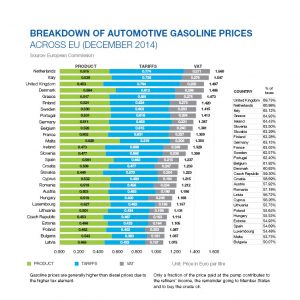You certainly heard, the price of oil has fallen from 100 USD in July 2014 to 30 USD today on international markets.
The price-unit for oil, the barrel, contains 160 liter. So 30 USD for 160 liter – I think this goes without a calculator – equals 0,18 USD or 0,8 RON per liter of oil.
The difference to the price you pay at the gas station starts with the ‘upstream’-companies, drilling for oil then sending it for refining.
Now the ‘downstream’ companies take over. The refineries convert the product into gasoline, after which it’s transported and distributed.
The gas is then marketed (i.e ads in magazines or fidelity-cards) and finally sold to the car drivers by a gas station.
Now, the drilling-, refining-, transportation-, distribution- and marketing-costs do not explain fully the different retail-price, people have to pay around the world to refill the fuel tank of their cars.
Below is the average price for 1 liter of gas in USD at petrol stations around the world for February 2016.
0,02 Venezuela
0,16 Saudi Arabia
0,56 Russia
0,69 USA
0,83 Ukraine
0,86 Mexico
0,90 Canada
0,91 Australia
0,94 Brazil
0,97 India
0,98 China
1,06 Japan
1,16 Poland
1,17 Bulgaria
1,19 Hungary
1,24 Serbia
1,24 Romania
1,25 Czech Rep.
1,25 Austria
1,29 Spain
1,30 Croatia
1,39 France
1,40 Singapore
1,42 Germany
1,44 Sweden
1,45 Switzerland
1,50 Finland
1,51 Portugal
1,52 Greece
1,52 Turkey
1,57 Israel
1,61 Italy
1,64 UK
1,69 Norway
1,73 Holland
1,86 Hong Kong
The huge differences in the retail prices are, of course, based on various taxes each country poses on the product. While Venezuela subsidizes the gas price with state money, the taxes in Europe have another effect.
Each time, you pay at Petrom OMV or any other station, more than half of this money goes to directly to your government. And in Romania, these taxes are not even extraordinary high – in the UK, they count for almost 70 percent of the gas price – as you can see in the chart below:

Taxes on gas prices in the EU
Now, at the end of our journey into the details of the gas price, I’d like to tell you a story from my home country Switzerland, where the average salary is considerably higher than in Romania. But when gas prices go up, my countrymen get mad about the same way romanians do.
They got even more angry, when they learned a few decades ago, that a big part of the price hike was based on higher taxes for the state.
But they calmed down, when they found out, that these taxes were actually used to build or repair roads.
My home country is 6 times smaller than Romania – and it has a lot of mountains. But it built 1500 km of 4-or 6-lane-highways so far. And the only slalom we know is on the ski-slopes, not to avoid the gropi. Wouldn’t it be a good idea to use the gas price-taxes exclusively for the same purpose in Romania?
———
2015 is over soon and 2016 is just around the corner. For investors, it might be a chance to profit from the ‘January-Effect’ at the markets. More on that and other calendar-trends in the financial world – coming up just in time in the next chapter: http://www.theleader.ro/calendar-trends/
 TheLeader Business, Economy, Stock Market, Management
TheLeader Business, Economy, Stock Market, Management
